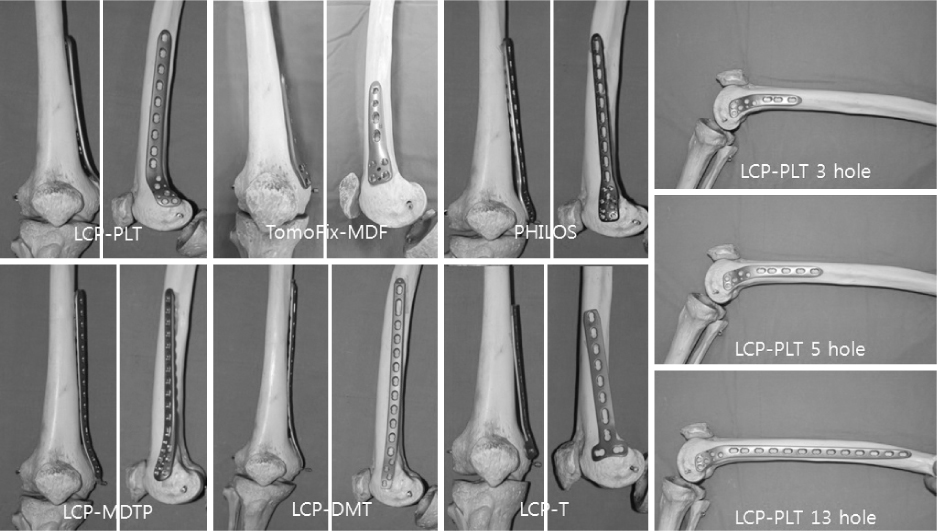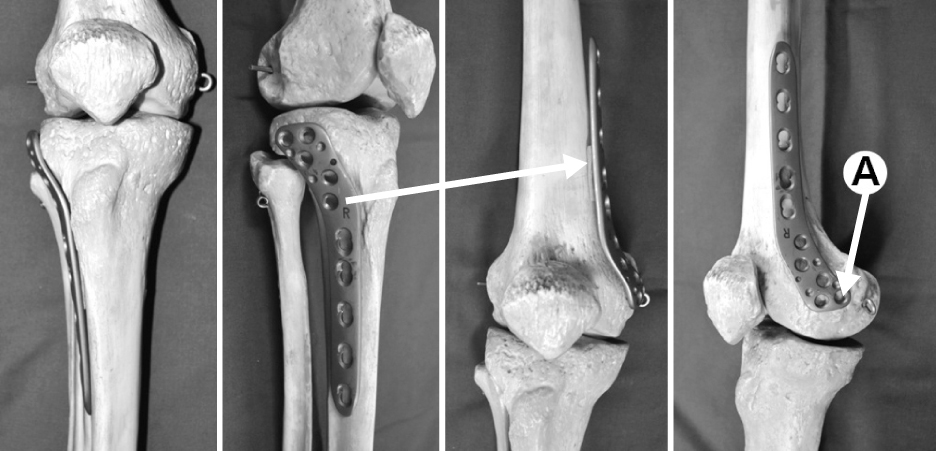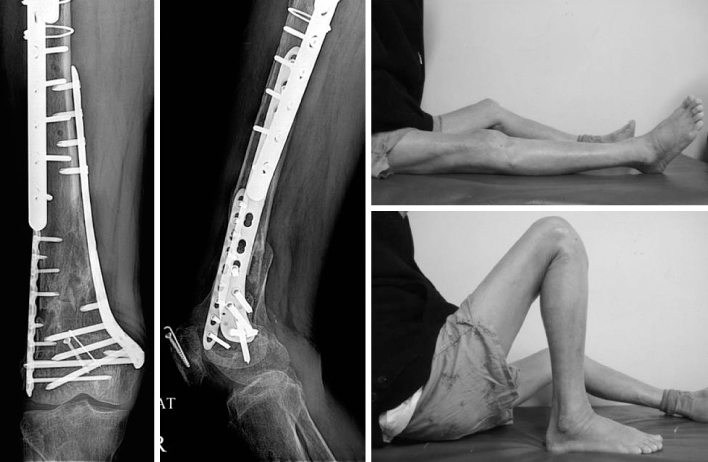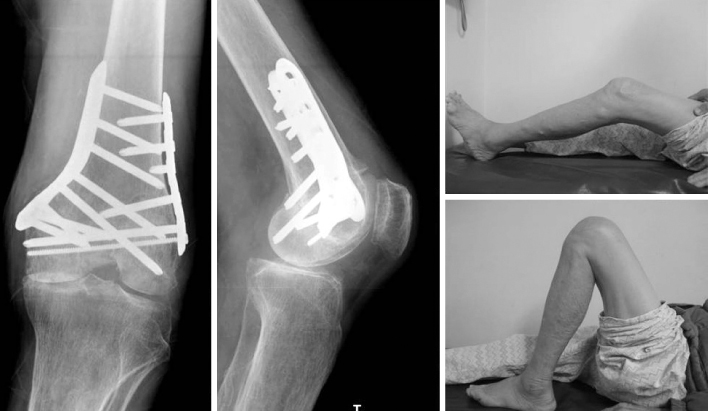J Korean Fract Soc.
2016 Jul;29(3):206-212. 10.12671/jkfs.2016.29.3.206.
Medial Plating of Distal Femoral Fracture with Locking Compression Plate-Proximal Lateral Tibia: Cases' Report
- Affiliations
-
- 1Department of Orthopaedic Surgery, Daegu Fatima Hospital, Daegu, Korea. aabga@hanmail.net
- KMID: 2344094
- DOI: http://doi.org/10.12671/jkfs.2016.29.3.206
Abstract
- Generally, lateral plating is used for a comminuted fracture of the distal femur. However, in some cases, it has been shown that using a medial plate is necessary to achieve better outcome. Nevertheless, there are no available anatomical plates that fit either the distal medial femoral condyle or fracture fixation, except for the relatively short plate developed for distal femoral osteotomy. We found that locking compression plate-proximal lateral tibia (LCP-PLT) fits anatomically well for the contour of the ipsilateral medial femoral condyle. Moreover, LCP-PLT has less risk of breaking the thread holes since it rarely needs to be bent. We report a plastic bone model study and two cases of distal femoral fractures fixed with medial plating using LCP-PLT.
MeSH Terms
Figure
Reference
-
1. Singh AK, Rastogi A, Singh V. Biomechanical comparison of dynamic condylar screw and locking compression plate fixation in unstable distal femoral fractures: an in vitro study. Indian J Orthop. 2013; 47:615–620.
Article2. Ha SS, Sim JC, Hong KD, Kim JY, Park KH, Choi YH. The surgical treatment of distal femur medial condyle fracture using lateral anatomical plate of opposite side through medial approach. J Korean Fract Soc. 2009; 22:246–251.
Article3. Boulton CL, Kim H, Shah SB, et al. Do locking screws work in plates bent at holes? J Orthop Trauma. 2014; 28:189–194.
Article4. Checroun AJ, Mekhail AO, Ebraheim NA, Jackson WT, Yeasting RA. Extensile medial approach to the femur. J Orthop Trauma. 1996; 10:481–486.
Article5. Schatzker J, Lambert DC. Supracondylar fractures of the femur. Clin Orthop Relat Res. 1979; 138:77–83.
Article6. Yune SH, Rhee KJ, Park CH, Byun KY, Lee SY, Rho SK. Importance of maintenance medial buttress in treatment of supra-condylar and inter-condylar (T-condylar) fracture of the femur. J Korean Soc Fract. 1996; 9:50–58.
Article7. Visser J, Brinkman JM, Bleys RL, Castelein RM, van Heerwaarden RJ. The safety and feasibility of a less invasive distal femur closing wedge osteotomy technique: a cadaveric dissection study of the medial aspect of the distal femur. Knee Surg Sports Traumatol Arthrosc. 2013; 21:220–227.
Article8. Jiamton C, Apivatthakakul T. The safety and feasibility of minimally invasive plate osteosynthesis (MIPO) on the medial side of the femur: a cadaveric injection study. Injury. 2015; 46:2170–2176.
Article9. Kim JJ, Oh HK, Bae JY, Kim JW. Radiological assessment of the safe zone for medial minimally invasive plate osteosynthesis in the distal femur with computed tomography angiography. Injury. 2014; 45:1964–1969.
Article
- Full Text Links
- Actions
-
Cited
- CITED
-
- Close
- Share
- Similar articles
-
- Effect of Additional Medial Locking Plate Fixation and Autogenous Bone Graft for Distal Femur Nonunion after Lateral Locking Plate Fixation
- Analysis of the Result Treated with Locking Compression Plate-Distal Tibia and Zimmer Periarticular Locking Plate in Distal Tibia Fracture
- Clinical Outcomes of Locking Compression Plate Fixation through Minimally Invasive Percutaneous Plate Osteosynthesis in the Treatment of Distal Tibia Fracture
- Minimally Invasive Percutaneous Plate Stabilization Using a Medial Locking Plate for Proximal Tibial Fractures: Technical Note
- Comparison of Results of Minimally Invasive Plate Osteosynthesis according to Types of Locking Plate in Distal Femoral Fractures








